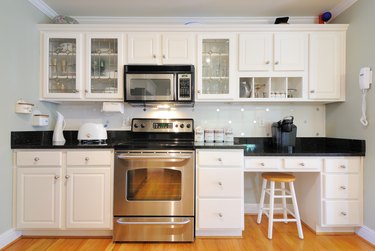The earliest ovens date back over 5,000 years when the ancient Greeks revolutionized cooking with front-loading bread ovens. Only 300 years ago did ovens really begin changing, thanks to the cast-iron cooker. In 1826, the gas stove and oven were invented, and 65 years later came electric ovens. The conventional oven today is largely based on electric ovens that began becoming commonplace on the eve of World War II.

Video of the Day
What's a Conventional Oven?
Conventional ovens have been a mainstay in the modern kitchen since the 1950s. They operate with bottom-up heat transfer from a stable, fixed source, usually a burner element or gas flame inside the oven house. Whether gas or electric, baking is essentially the same – the heat rises and cooks the food from underneath.
Video of the Day
There's a broil function as well. To make cheese melt, you'd pop the dish a couple of inches under the broiler and the overhead heat ensures the cheese gets melty and gooey, just the way you like it. Many modern electric conventional ovens allow you to use both the top and bottom features at once.
What’s a Convection Oven?
Convection ovens can be stand-alone or an added feature of conventional, toaster and even microwave ovens. When incorporated into conventional ovens, convection mode is often indicated by a dial setting with a fan icon. The convection fan circulates hot air, ensuring heat comes at the food from all sides, and this is the big difference from conventional cooking.
The upside to convection is it cooks food quicker but also more crisply. If you like baked potato wedges, for instance, convection makes them crisper and more evenly cooked. A chicken roasts far quicker and gets crispier skin in convection, almost like a rotisserie grill. You can also cook more than one dish in convection because the heat circulates.
But if you're baking, say, a lemon meringue pie, the top may overcook because pies and their recipes are designed to bake from the bottom up. In fact, bakers find convection ovens to be problematic, especially with bread, which often won't rise as it does in bottom-up heat since the convection fan creates a crust faster and prematurely kills the rise. This is easily solved, though, if you can turn off the convection fan and cook with conventional fixed heat.
Should You Get a Convection Oven?
The best choice is a convection stove or oven that can have the fan turned off in favor of noncirculating conventional bottom-up heat. This way, if you're baking cookies or a slab of focaccia bread, it'll cook properly.
But, then again, when it's Thanksgiving and you're trying to cram four different dishes in to cook after the turkey, convection means you can cook them all well without having to rotate them every few minutes since the heat is consistent throughout the oven. They'll cook more quickly too.
Convection means two adjustments, though – realizing that most recipes won't have accurate cooking times if you're using the speedier convection mode and you'll need low-rise cookware so more cooking surface meets with the fanned air.
Other Ovens with Convection Options
- Toaster ovens have been popular since the 1970s. It was groundbreaking for families to be able to make six or even eight slices of toast at once. The "toast" feature means heat comes from the top and bottom elements simultaneously. These workhorses can also perform as secondary ovens. Today, most come with convection options, or the next level of convection, the "air-fryer," which circulates air even faster and yields far crispier result on things like chicken and baked French fries.
- Microwaves are commonly available now with convection too, allowing cooks to get a better texture with some foods, alleviating the main complaint about cooking with microwaves.